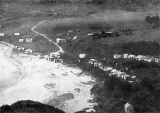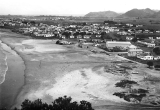Waihi Borough Council Diamond Jubilee Booklet 1902-1962
ITS HISTORIC IMPORTANCE
Practically every tourist in the Auckland Province knows of the beauty and delightful bathing facilities at the Waihi Beach. There are very few, however, even in Waihi, who are familiar with the interesting history connected with this resort, or realise that the last cannibalistic feast in New Zealand was celebrated in the Athenree Gorge.
To deal with the history of our Beach, one must include the area between Mataura and Matakana Island, inhabitated by one tribe of Maoris from the beginning of their visitation to New Zealand. When the first Maori immigration from Polynesia was in progress, about 1350 A.D., one section, in the canoe "Arawa", commanded by Chief Tama Te Haupua, landed at Oparoa, the south-east spit of Matakana Island and, making its headquarters at Katikati, split into sub-tribes, hapaus [hapus? – E], and peopled an area as far as Mataura.
They each built fortifications, and in time increased to such an extent that separate tribes sprang up at Bowentown, Athenree, Kauri Point, Waihi Beach and Mataura. They cultivated the land from the sea to the foot of the hills, but relied mainly on their remarkable skill as fishermen, both on the sea and muddy creeks, to give them their supply of food. This supply was abundant, the soil was very fertile and the tribes prospered and became probably the most powerful in New Zealand. While their wives tended the crops and did the general work, including the grinding of flour from fern roots, the men made and polished adzes, meres, and bone spear-heads. At this work they were skilful and, unlike their Hauraki kinsmen, took a great pride in polishing and finishing effects. Although they had all their needs for bodily warmth and comfort, they craved for the valuable greenstone, found only in the South Island. Consequently they engaged in a system of barter, a custom prevalent also amongst their northern neighbours.
The first to discover valuable data concerning tribes, native to these parts, was Captain Gilbert Mair, who happened to find a section of a Maori workshop, laid bare by a prevailing westerly wind. Upon thoroughly searching this area he discovered about 200 adzes, chisels, greenstone adzes, bone spear-heads, fish hooks, bone needles and greenstone ornaments. Some of this find was considered valuable and took its place in the Maori section of the Auckland Museum. In 1912 Messrs R. W. Bell and S. M. Hovell were successful in discovering a very extensive workshop, situated about 100 yards from Mair's original find. A systematic excavation of the newly discovered region disclosed nearly 2000 adzes and anvils, quartzite and jasper hammers, together with hundred of other articles, too many to enumerate. With these were large flakes of rock showing where the chipping process in the manufacture of the adze had been executed. The following year evidence was found of a huge eel weir on Shaw's property at the Beach, while during the draining operations of the swamp several valuable eel pots and wooden implements were found.
In fact, the whole of the beach area is alive with historic interest and offers a splendid field for the student who would care to do some little research and incidentally enjoy himself at a beautiful ocean resort.
— Harry Brice, 1st prize. Forms V and VI. (Reo Mano, 1933).


